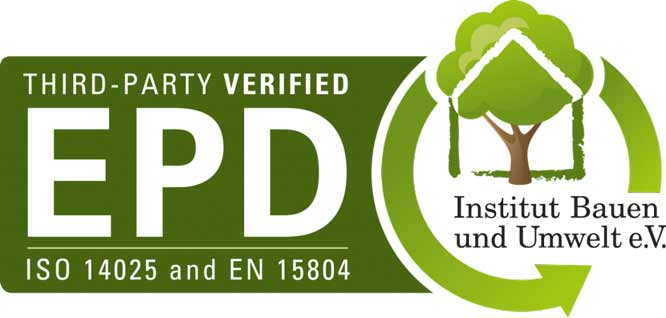What is an EPD? Purpose and Use of Environmental Product Declarations
- Definition of an EPD
- EPD – A Type III Environmental Label
- The EPD Programme: Based On International Standards
- EPD – An Important Data Basis for Sustainable Building
- EPDs Provide Transparent and Neutral Documentation on Environmental Impact
- The Added Value Environmental Product Declarations (EPDs) Provide – An Overview:
Definition of an EPD
EPD is an abbreviation for Environmental Product Declaration. An EPD describes building materials, construction products, or building components in terms of their environmental impact, based on life cycle assessments, as well as on their functional and technical characteristics. This quantitative, objective, and verified information covers the entire life cycle of the building product. EPDs thus constitute an important basis for assessing building sustainability.
EPD – A Type III Environmental Label
In addition to legally-mandated product labelling – CE labels, for instance – there are several voluntary environmental labels, which are divided into three categories. EPDs are associated with Type III environmental labels: In IBU EPDs, the scientifically-determined values from a product’s life cycle assessment are summarised and documented in a uniform format: factual, neutral, scientifically sound and, above all, unbiased. It is precisely this aspect that differentiates EPDs from Type I and Type II environmental labels. The EPD is not a certificate. There are no requirements with regard to product quality, but rather, in terms of the quality and format of the data. EPDs are based on the ISO 14025 and EN 15804 standards. Prior to publication by the IBU, EPDs are tested and verified by independent third parties for completeness, plausibility, and conformance to standards. The quantitative information contained in EPDs on the environmental performance of construction products makes them valuable to a wide range of stakeholders: planners, architects, construction companies, investors, facility managers, and, of course, manufacturing and service companies along the entire value chain, from raw materials to finished buildings.
The EPD Programme: Based On International Standards
ISO 14025 sets forth regulations on the principles and procedures for Type III environmental labels, which provide quantified environmental information over the life cycle of a product. This allows comparisons to be made between products that serve the same function. Again, the basis for an EPD is the life cycle assessment, conducted in accordance with ISO 14040/44.
EN 15804 specifies the basic rules for EPDs in the category of building products. These fundamental product category rules ensure that all EPDs for construction products, building activities, and construction processes are derived, depicted, and verified in a uniform manner. EN 15804 stipulates the conditions for EPDs that are valid Europe-wide.
EPD – An Important Data Basis for Sustainable Building
Sustainable building involves examining and assessing buildings in terms of their ecological, economic, and social qualities. EPDs for building materials, construction products, and building components permit ecological aspects to be included in sustainability assessments of buildings. EPDs provide building product data relevant to the construction of sustainable buildings as well as for building certifications. This consists primarily of basic data that can be used for assessing the ecological quality of a building. The equally comprehensive and detailed life cycle assessment data and information contained in EPDs is uniformly summarised and presented in a concise overview consisting of only a few pages. It forms the basis for describing and assessing structures, allowing those buildings with an especially low environmental impact can be identified. To accomplish this, a life cycle assessment is performed, in which the entire lifespan of the building, from the construction phase to the use phase, including possible changes in usage, as well as dismantling and disposal are taken into consideration. EPDs provide information about a number of different indicators. For instance, EPDs reveal how building products contribute to energy efficiency or to other aspects of sustainable building management. Internationally-recognised EPDs are therefore crucial cornerstones for such building certification systems as DGNB, BNB, BREEAM, and LEED.
EPDs facilitate not only life cycle and building assessments, but are also an aid to integral planning. As early as in the design phase, EPDs allow architects and planners to compare different components, construction methods, and options, and select the ideal combination of construction products for the specific building in question.
Whether architects, planners, engineers, building owners, facility managers, or auditors – the publicly-available EPDs make it possible for anyone with an interest to obtain an overview of life cycle assessment key figures and product-related environmental impact.
EPDs Provide Transparent and Neutral Documentation on Environmental Impact
 As environmental labels, EPDs are suitable for all building-related products and services. Since building materials as well as construction products and building components are intermediate, not end products, they are not per se either environmentally friendly or harmful. Their influence on the environment is dependent upon many factors, as the environmental impact of individual building products will ultimately be determined by their interaction within a building. For instance, the use of a construction product made from natural raw materials is not by itself a guarantee of sustainability. For sustainable building, the fact that a product has received a positive assessment of its individual environmental characteristics, as, for instance, with Type I environmental labels, is not sufficient. Every product must be viewed holistically. This is because in order to be able to determine and assess the ecological dimensions of a structure’s sustainability, it is necessary to have complete information about all of the characteristics and environmental influences of the installed products, including their interaction. EPDs provide verified datasets that are used to create the building’s life cycle assessment. For this reason, Type III environmental product declarations, i.e. EPDs, are used in the planning of sustainable buildings and in the assessment of their ecological sustainability.
As environmental labels, EPDs are suitable for all building-related products and services. Since building materials as well as construction products and building components are intermediate, not end products, they are not per se either environmentally friendly or harmful. Their influence on the environment is dependent upon many factors, as the environmental impact of individual building products will ultimately be determined by their interaction within a building. For instance, the use of a construction product made from natural raw materials is not by itself a guarantee of sustainability. For sustainable building, the fact that a product has received a positive assessment of its individual environmental characteristics, as, for instance, with Type I environmental labels, is not sufficient. Every product must be viewed holistically. This is because in order to be able to determine and assess the ecological dimensions of a structure’s sustainability, it is necessary to have complete information about all of the characteristics and environmental influences of the installed products, including their interaction. EPDs provide verified datasets that are used to create the building’s life cycle assessment. For this reason, Type III environmental product declarations, i.e. EPDs, are used in the planning of sustainable buildings and in the assessment of their ecological sustainability.
EPDs Contain Information On a Product’s Environmental Effects
Rather than assessing the individual characteristics of a product, EPDs, on the basis of life cycle assessments, document all relevant environmental aspects in a transparent, independent, and comprehensible manner. EPDs provide clear information about the environmental impact of the product throughout its complete life cycle. The entire process is reviewed – from raw material extraction to production, transport, and installation into the building, up to and including the end-of-life stage and disposal or recycling options. EPDs contain quantitative product information derived from life cycle assessments. This includes statements regarding energy and resource utilisation, the amount of waste generated, and information on the extent to which a product contributes to such factors as greenhouse effect, acidification, over-fertilisation, ozone depletion, and smog formation.
EPDs Contain Information On a Product’s Functional and Technical Characteristics
The assessment of a construction product’s performance within the context of an entire building is based on various technical specifications. These include, e.g. information on pressure resistance, lifespan, or thermal and acoustic insulation. An EPD may also include environmental and health-related data, such as emissions into indoor air.
EPDs Provide Information On Recycling Management and Disposal
EPDs also indicate what will be done with a construction product or its components during the end-of-life phase: Whether it will be disposed of, thus ending its life cycle (cradle to grave), or whether, and to what extent, it can be re-entered into the production cycle (cradle to cradle) thereby contributing to resource efficiency. This clarity and transparency make it possible to calculate the long-term effect of individual components on the ecosystem.
The Added Value Environmental Product Declarations (EPDs) Provide – An Overview:
EPDs Represent Objectivity, Transparency, and Credibility
- EPDs provide scientifically-based, quantitative data from life cycle assessments, detailing all of a construction product’s pertinent environmental effects in a transparent, unbiased, and comprehensible manner.
- EPDs are verified by independent third parties who examine the data for completeness, plausibility, and compliance with standards.
- EPDs are based upon international standards and are internationally recognised.
- EPDs are publicly accessible at the following sites:
- IBU website: published EPDs (downloadable PDFs)
- BBSR building materials database: ÖKOBAUDAT
- IBU database: IBU.data
EPDs Contribute to Sustainable Construction
- EPDs facilitate integral planning for construction projects by providing information to aid in environmentally-conscious planning as well as in purchasing decisions.
- EPDs serve as an important data basis for ecological building assessment.
- EPDs are recognised by Green Building Certification systems.
EPDs Enhance the Market Position of Construction Product Manufacturers
- Manufacturers who create EPDs for their construction products and building components are sustainability pioneers.
- EPDs make it easier for manufacturers to gain access to publicly-advertised construction projects.
EPDs promote sustainability strategies within companies
- EPDs reveal the potential for product optimisation, e.g. where material and energy cost reductions can be achieved in product manufacturing.
- EPDs reveal hotspots in a product’s life cycle, e.g. with regard to the increasing energy efficiency of a product during its use phase.
- EPDs reveal the potential for optimising company processes, e.g. logistics or operating costs.

